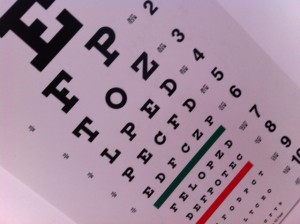During an eye examination, I always use the eyechart to measure the distance vision, usually with the most current glasses or contact lenses. This gives me a place to begin and tells me what sort of vision a person has and a quantity to compare. 
The classic example of an eye chart is the Snellen eye chart, developed by Dutch eye doctor Hermann Snellen in the 1860’s. There are many variations of the Snellen eye chart, but in general it has 11 rows of capital letters. The top row contains one letter (usually an E). the other rows contain letters that are progressively smaller.
In the United States, the standard placement of the eye chart is on a wall that’s 20 feet away from your eyes. Since most of our exam rooms are shorter than 20 feet we use mirrors to simulated the 20 foot distance. 20/20 vision is considered “normal vision”, meaning you can read at 20 feet a letter that most human beings should be able to read at 20 feet.
In the US a person is considered “legally blind” if his best-corrected visual acuity with glasses or contact lenses is 20/200 or worse. To get a driver’s license in California a person must have at least 20/40 best corrected acuity.
An eye chart is a measure of visual acuity only. It is an aid to prescribing glasses and contact lenses. But eye charts don’t measure peripheral vision, depth perception, or color perception. They also don’t determine the ocular health.
The visual acuity measurements done with the Snellen eyechart are simply a starting place for any eye examination, a method to quantify it.
